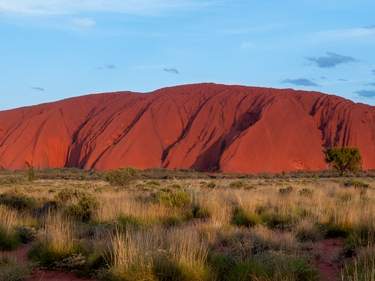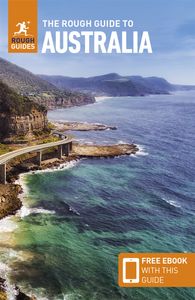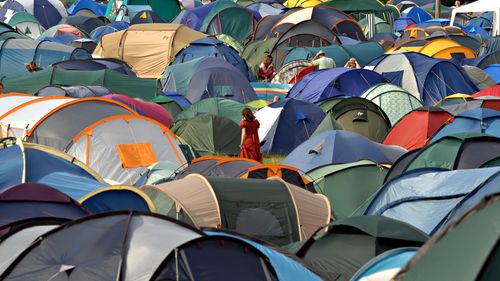Blue Mountains region
The section of the Great Dividing Range nearest Sydney gets its name from the blue mist that rises from millions of eucalyptus trees and hangs in the mountain air, tinting the sky and the range alike. In the colony’s early days, the Blue Mountains were believed to be an insurmountable barrier to the west. The first expeditions followed the streams in the valleys until they were defeated by cliff faces rising vertically above them. Only in 1813, when the explorers Wentworth, Blaxland and Lawson followed the ridges instead of the valleys, were the “mountains” (actually a series of canyons) finally conquered, allowing the western plains to be opened up for settlement. The range is surmounted by a plateau at an altitude of more than 1000m where, over millions of years, rivers have carved deep valleys into the sandstone, and winds and driving rain have helped to deepen the ravines, creating a spectacular scenery of sheer precipices and walled canyons.
Before white settlement, the Daruk Aborigines lived here, dressed in animal-skin cloaks to ward off the cold. An early coal-mining industry, based in Katoomba, was followed by tourism, which snowballed after the arrival of the railway in 1868; by 1900, the first three mountain stations of Wentworth Falls, Katoomba and Mount Victoria had been established as fashionable resorts, extolling the health-giving benefits of eucalyptus-infused mountain air. In 2000, the Blue Mountains became a UNESCO World Heritage Site, joining the Great Barrier Reef; the listing came after abseiling was finally banned on the mountains’ most famous scenic wonder, the Three Sisters, after forty years of clambering had caused significant erosion. The Blue Mountains stand out from other Australian forests in particular for the Wollemi pine, discovered in 1994, a “living fossil” that dates back to the dinosaur era.
All the villages and towns of the romantically dubbed “City of the Blue Mountains” lie on a ridge, connected by the Great Western Highway. Around them is the Blue Mountains National Park, the state’s fourth-largest national park and to many minds the best. The region makes a great weekend break from the city, with stunning views and clean air complemented by a wide range of accommodation, cafés and restaurants. But be warned: at weekends, and during the summer holidays, Katoomba is thronged with escapees from the city, and prices escalate accordingly. Even at their most crowded, though, the Blue Mountains offer somewhere where you can find peace and quiet, and even solitude – the deep gorges and high rocks make much of the terrain inaccessible except to bushwalkers and mountaineers. Climbing schools offer courses in rock climbing, abseiling and canyoning for both beginners and experienced climbers, while Glenbrook is a popular mountain-biking spot.
The Six Foot Track
Along the Great Western Highway, about 2.5km west of Katoomba train station, is the Explorers Tree, inscribed with the initials of Blaxland, Lawson and Wentworth during their famous 1813 expedition. From Nellies Glen Road here is the start of the 42km Six Foot Track to the Jenolan Caves (2–3 days; carry plenty of water) and shorter walks to Pulpit Rock and Bonnie Doon Falls. There are four basic campsites along the way, plus well-equipped cabins at Binda Flats. Blackheath NPWS (02 4787 8877) can provide more bushwalking and camping information. Blue Mountains Guides (02 4782 6109, bluemountainsguides.com.au) offer a guided walk along the track. Otherwise, Fantastic Aussie Tours provide a return service from Jenolan Caves for those who have completed the walk. A more unusual way to do the track is to enter Australia’s largest annual off-road marathon, the Six Foot Track Marathon held in March (coolrunning.com.au).
Safety in the Blue Mountains
Walkers go missing in the Blue Mountains with distressing regularity, and there have been recent instances of backpackers disappearing without trace. The mountains are extremely wild, and you can lose your bearings quickly. Never leave the marked paths, and use a guide for long-distance walks. Bear in mind that due to the high elevation, night-time temperatures dip pretty low in winter, when you should take an extra layer and waterproofs.
Wollemi pine
A famous feature of the Katoomba region is the “dinosaur trees”, a stand of 30m-high Wollemi pine, previously known only from fossil material over sixty million years old. The trees – miraculously still existing – survive deep within a sheltered rainforest gully in the Wollemi National Park, north of Katoomba, and they made headlines when they were first discovered in 1994 by a group of canyoners. The first cultivated Wollemi pine was planted in 1998 at Sydney’s Royal Botanic Gardens, and you can see one in the YHA hostel in Katoomba.
Close wildlife encounters around Sydney
Australian Reptile Park This park (reptilepark.com.au), 65km north of Sydney, just off the Pacific Hwy before the Gosford turn-off, offers photographic opportunities with koalas, and has roaming kangaroos, though its real stars are the reptiles, with native Australian species well represented and visible all year round thanks to heat lamps in the enclosures. The highlights are Elvis, New South Wales’ largest saltwater crocodile, and the sizeable perentie lizard of central Australia. There are reptile shows and talks throughout the day, including giant Galapagos tortoise feeding, alligator feeding and a crocodile show, featuring Elvis.
Featherdale Wildlife Park Located 30km west of Sydney off the M4 motorway between Parramatta and Penrith, at 217 Kildare Rd, Doonside (featherdale.com.au). There are feeding sessions and talks throughout the day focusing around koalas, flying foxes, dingoes and other animals. Train to Blacktown Station, then bus #725.
Koala Park Sanctuary Established as a safe haven for koalas in 1935, the sanctuary (koalapark.com.au) has since opened its gates to wombats, possums, kangaroos and native birds of all kinds. Koala-feeding sessions are the photo-opportunity times. Around 25km north of Sydney, not far from the Pacific Hwy on Castle Hill Rd, West Pennant Hills; train to Pennant Hills then bus #651 or #655 towards Glenorie.
Heathcote National Park
Heathcote National Park, across the Princes Highway from the Royal National Park, is much smaller and quieter. This is a serious bushwalkers’ park with no roads and a ban on trail bikes. You can follow the fairly hilly Bullawarring Track (12km one way; 5hr; moderate difficulty) north from Waterfall station and join a later train from Heathcote. The track weaves through a variety of vegetation, including scribbly gums with their intriguing bark patterns, and spectacular gymea lilies with bright red flowers atop tall flowering spears in the spring. Along the path are several swimmable pools fed by Heathcote Creek – the carved sandstone of the Kingfisher Pool is the largest and most picturesque.
The Hunter Valley
New South Wales’ best-known wine region and Australia’s oldest, the Hunter Valley is an area long synonymous with fine wine – in particular, its golden, citrusy Sémillon and soft and earthy Shiraz. In recent years, the region has become equally prized for its restaurant and cultural scene: visitors are treated to some of the best the country has to offer in the way of fine dining, gourmet delis, arts and crafts, and outdoor events and festivals.
Wine, however, is still the main attraction. The first vines were planted in 1828, and some still-existing winemaker families, such as the Draytons, date back to the 1850s. In what seems a bizarre juxtaposition, this is also a very important coal-mining region, in the Upper Hunter Valley especially. By far the best-known wine area is the Lower Hunter Valley, nestled under the picturesque Brokenback Range, fanning north from the main town of Cessnock to the main wine-tasting area of Pokolbin. Cessnock, unfortunately, is a depressingly unattractive introduction to the salubrious wine culture surrounding it, though its big old country pubs offer cheaper accommodation options. Broke Fordwich is an easy fifteen-minute drive from the hectic centre of Pokolbin and also has many wonderful wineries, many of them boutique.
The area can seem a little like an exhausting winery theme park; to experience the real appeal of the Hunter Valley wine country, explore the region’s periphery. Take the scenic, winding Wollombi Road to the charming historic town of Wollombi, 28km southwest of Cessnock; or try the Lovedale/Wilderness Road area, to the northeast, and the still unspoilt Upper Hunter, west of Muswellbrook, with its marvellous ridges and rocky outcrops.
Hunter valley festivals and events
A Day on the Green On multiple dates from November to February, Bimbadgen Estate holds A Day on the Green, featuring local and international performers. Tickets bookable through ticketek.com.au or adayonthegreen.com.au.
Jazz in the Vines A day of fine food, wine and music at Jazz in the Vines, based at Tyrrell’s vineyard (jazzinthevines.com.au).
Lovedale Long Lunch Every year over a mid-May weekend, around eight wineries along and around the scenic Lovedale and Wilderness roads team up with local restaurants to host the Lovedale Long Lunch (02 4990 4526, lovedalelonglunch.com.au).
Opera in the Vineyards In late October, Wyndham Estate hosts the night-time Opera in the Vineyards (wyndhamestate.com).
Sculpture in the Vineyards From early October to mid-January, the Wollombi region hosts Sculpture in the Vineyards, in which surreal and innovative site-specific sculptures dazzle among the vineyards, valleys, dirt roads and bushy ridges of picturesque Wollombi’s wineries (sculptureinthevineyards.com.au).
Wine tasting in the Hunter Valley
Nearly 150 wineries cluster around the Lower Hunter Valley and fewer than twenty in the Upper Hunter; almost all offer free wine tastings. Virtually all are open daily, at least between 10am and 4pm, and many offer guided tours. Try to tour the wineries during the week; at weekends, both the number of visitors and accommodation prices go up, and the area can get booked out completely when there’s a concert on in the valley. Listed here are a few more of our favourites, but you’ll inevitably discover your own gems.




















